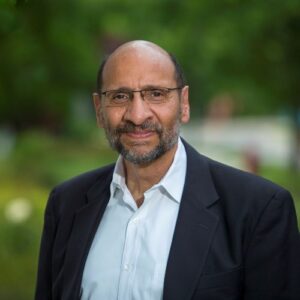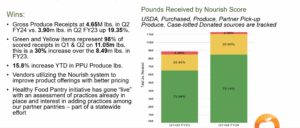Food banks and pantries know they are really good at getting healthy food to vulnerable people. Increasingly, the healthcare industry is understanding that as well.
Both healthcare payers and providers are seeking ways to more fully partner with experts in hunger relief. They realize food banks and pantries not only have deep connections to individuals in need, but also the logistical ability to get food into communities where it’s needed.
Those strengths can be a huge help to healthcare entities as they embrace food as medicine – the idea that food and nutrition security is essential to improving community health. “We want to make sure that we’re investing in and working with partners that are doing phenomenal work on the ground,” said Dr. Kofi Essel, Food as Medicine Director at Elevance Health, a health plan provider with more than 47 million members nationwide.

Healthcare’s reasons to want to work more closely with hunger relief also have to do with cost. Elevance notes that 80% of its healthcare outcomes and costs are tied to social factors like a lack of nutritious food and stable housing. Among its own Medicaid health plan members, Elevance found that 75% have multiple health-related social needs, with each of those needs driving up an individual’s healthcare costs by about $1,500 a year.
Blue Cross Blue Shield North Carolina has also assessed its member base to find that food insecurity specifically is dragging down member health, while raising costs. It predicted that 20% of its members across all of its health plans are food insecure, and of those, nearly half go to the emergency room more often, at a cost of about $45 million annually. So addressing non-clinical factors of health, like food and housing, “is not only the right thing to do, but the right business thing to do,” said Dr. John Lumpkin, Executive Strategic Counselor, Marketing and Corporate Social Responsibility, in a recent webinar.
Another reason healthcare is reaching out to hunger relief is because of a newly rigorous requirement from the Joint Commission overseeing healthcare organizations that they assess health-related social needs in their communities, and document that they executed on a plan to address them. Julie Butner, President and CEO of Tarrant Area Food Bank, is seeing the impact of this requirement at her food bank. Noting that food security always emerges as a top-three community need, Butner said, “We now have the big healthcare systems in our community reaching out to us saying, ‘We want to include you in our solutions for addressing food insecurity.’”
It’s difficult for the healthcare industry to address health outcomes that are linked to community needs, rather than clinical factors, Dr. Essel said. “Healthcare by itself should not be doing it all and cannot do it all. So working with established organizations that are tried and true that have been respected for generations is really important for us,” he said.
Elevance Health is putting its money where its mouth is. In September 2022, it announced a $14.1 million investment through its foundation to continue its work with various Feeding America food banks on a Food as Medicine program that will run through 2025. The investment, which is the foundation’s largest ever, comes on top of $1 million contributions to Feeding America each in 2019 and 2021.

Blue Cross Blue Shield North Carolina is also courting nonprofit organizations as it seeks to address food insecurity amongst its members. When it piloted a food delivery program recently, it ran into issues when the vendor contracted to deliver food boxes proved unreliable. “Our mission is to improve the health and well-being of our customers and community,” Dr. Lumpkin said. “We need to make sure that the food box is there.”
He called for a “for-profit not-for-profit solution” to execute food delivery and other interventions, and pledged to meet nonprofits halfway so they could participate without having to navigate cumbersome healthcare payment systems. “As we build out these programs, we’ll look for ways to partner with nonprofits in ways that don’t raise their administrative costs, but enable them to carry out their mission to address hunger and food insecurity in a way that will also benefit our members,” Dr. Lumpkin said. (For more on Blue Cross Blue Shield North Carolina’s work with nonprofits, see our article here.)
In Indiana, Gennesaret Free Clinics is seeing great value in partnering with hunger relief agencies so it can reach more people who need medical help. The nonprofit provides healthcare services to low-income and homeless populations, and has a mission to ensure every person in Indianapolis has access to quality care. It has found that the location where care is provided is critical.
Until recently, Gennesaret had partnered with a community/childcare center in an under-resourced neighborhood. But with the clinic positioned in the back of the building, few people were stopping in. “We realized that we really needed to go to the place where more people were congregating,” said Theresa Patterson, Executive Director.
Gennesaret identified a client-choice food pantry inside a local St. Vincent de Paul agency that is open four days a week as an optimal place to co-locate and soon saw the number of people going to its clinic nearly triple, from 2,600 annually to 6,700. “It’s a highly utilized food pantry,” Patterson said. “That’s the main attraction to us.”
Now Gennesaret is intent on establishing similar beachheads throughout the city. It already is working with Gleaners Food Bank to bring healthcare services to Gleaners’ on-site pantry. And it has its eye on a partnership with another pantry as well. “We’d love to attach a free medical clinic to every highly utilized food pantry around the city until everyone has access to healthcare,” Patterson said.
To franchise the model, Gennesaret has created a playbook that outlines all the steps and costs related to co-locating a clinic and a pantry. “I’m talking about a replicable model so you could plunk a clinic wherever you have a highly utilized food pantry,” Patterson said, adding, “I feel like we’re very much onto something with what we’re doing here in Indianapolis.” – Chris Costanzo
CAPTION FOR PHOTO, TOP: Gennesaret has co-located one of its free clinics (waiting lobby shown here) within a highly utilized client-choice food pantry.
Like what you’re reading?
Support Food Bank News
This article was made possible by the readers who support Food Bank News, a national, editorially independent, nonprofit media organization. Food Bank News is not funded by any government agencies, nor is it part of a larger association or corporation. Your support helps ensure our continued solutions-oriented coverage of best practices in hunger relief. Thank you!
Connect with Us:










